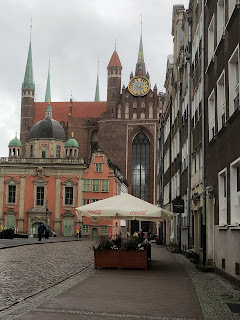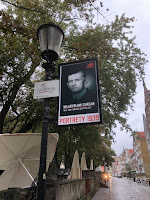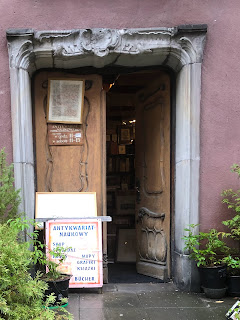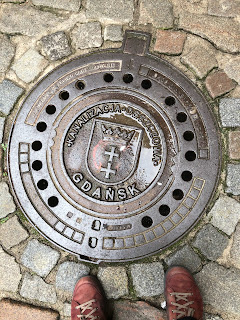What caught my interest, specifically, about Dear Peter, Dear Ulla by BC author Barbara Nickel, was the German setting of Gdańsk (now a Polish city). Any time you visit a place, in person, revisiting it on paper makes for a stronger connection. I spent three days in Gdańsk at the end of my Baltic cycling trip and was enthralled with its history and beauty.
 |
| Neptune fountain (mentioned in Nickel's novel |
 |
| View of St, Marienkirche /St Mary's mentioned in Nickel's novel |
Now through Barbara Nickel’s book, centered around the 1939 Nazi invasion of Poland and the attack on the Polish Post Office, I’m learning more of the beautiful city’s brutal history.
Gdańsk still is a beautiful city. The old city centre has been meticulously restored. It was a delight to wander down its pedestrian friendly streets, hunting for that perfect piece of amber jewelry, admiring restored buildings, and stepping through century-old doorways. What a statement of pride . . . to rebuild, to remember and to honour the history of a place and its people. Gdańsk is like a piece of amber. Unlike Kaliningrad (former Königsberg)—which under Soviet control after the war, chose to demolish the ruins—Gdańsk has rebuilt and remembered.
 |
| Portraits of Polish war heroes lined the streets |
 |
| Old doorway leading to old books in the restored old city of Gdańsk |
That’s why I love reading historical books. Fiction like Barbara Nickel’s YA novel, Dear Peter, Dear Ulla, also rebuilds and remembers. Like pieces of amber, books can also carry secrets of time.




1 comment:
I haven't been that far north in Poland yet, but whenever I see Gdansk in documentaries, it strikes me as an absolutely beautiful city. I once applied for a cat-sitting there, but I was not successful. :-(
By the way, thank you very much for your support for my blog!
A postcard is on its way, from one of those Polish-German towns, coincidentally...
Andreas
Post a Comment